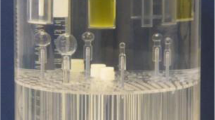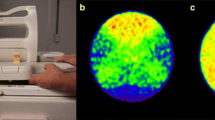Abstract
Objective
The objective of this study was to assess differences in the semiquantitative values of 18F-fluorodeoxyglucose (18F-FDG) uptake among different positron emission tomographic (PET) systems.
Methods
A phantom study was performed to compare standardized uptake value (SUV) in five PET scanners including a dedicated PET scanner and four PET/computed tomography (CT) scanners. Radioactivity simulating the SUV of 2.5 was filled in the hot spheres (8 mm, 11 mm, 14 mm, 18 mm, 22 mm, and 27 mm) that were set in the cylindrical phantom with the background SUV of 1.0. Data acquisition and reconstruction were performed according to routine and standardized conditions. The standardized condition was as follows: CT acquisition (120 kVp, 50 mA) and PET acquisition (2-min acquisition with a slice thickness of 2 mm); reconstruction was performed by ordered subsets expectation maximization + Fourier rebinning. Detectability of hot spheres and SUV was compared between routine condition and standardized condition with five PET scanners.
Results
On routine condition, two cameras could detect a 14-mm sphere clearly. On the other hand, the visualization of hot spheres by the standardized condition was remarkably variable. Semiquantitative evaluation revealed that a maximum of 45.7% error was recognized with the 27-mm sphere by the routine condition, although the standardized condition could reduce the error to 22.6%.
Conclusions
Detectability depends not only on the PET machine but also on the imaging protocol. The results indicate that SUV is variable with PET machines under routine conditions of data acquisition and reconstruction. Standardization of the reconditions can reduce variability and maximum difference in the SUV by half.
Similar content being viewed by others
References
Zhang H, Inoue T, Tian M, Alyafei S, Oriuchi N, Khan N, et al. A basic study on lesion detectability for hot spot imaging of positron emitters with dedicated PET and positron coincidence gamma camera. Ann Nucl Med 2001;15:301–306.
Kubota K, Matsuzawa T, Ito M, Ito K, Fujiwara T, Abe Y, et al. Lung tumor imaging by position emission tomography using C-11 l-methionine. J Nucl Med 1985;26:37–42.
Strobel K, Rudy M, Treyer V, Veit-Haibach P, Burger C, Hany TF. Objective and subjective comparison of standard 2-D and fully 3-D reconstructed data on a PET/CT system. Nucl Med Commun 2007;28:555–559.
van Dalen JA, Visser EP, Vogel WV, Corstens FHM, Oyen WJG. Impact of Ge-68/Ga-68-based versus CT-based attenuation correction on PET. Med Phys 2007;34:889–897.
Westerterp M, Pruim J, Oyen W, Hoekstra O, Paans A, Visser E, et al. Quantification of FDG PET studies using standardized uptake values in multi-centre trials: effects of image reconstruction, resolution and ROI definition parameters. Eur J Nucl Med Mol Imaging 2007;34:392–404.
Cherry SR, Dahlbom M, Hoffman EJ. 3D PET using a conventional multislice tomograph without septa. J Comput Assist Tomogr 1991;15:655–668.
Mawlawi O, Podoloff DA, Kohlmyer S, Williams JJ, Stearns CW, Culp RF, et al. Performance characteristics of a newly developed PET/CT scanner using NEMA standards in 2D and 3D modes. J Nucl Med 2004;45:1734–1742.
Defrise M, Kinahan PE, Townsend DW, Michel C, Sibomana M, Newport DF. Exact and approximate rebinning algorithms for 3-D PET data. IEEE Trans Med Imaging 1997;16:145–158.
Comtat C, Kinahan PE, Defrise M, Michel C, Townsend DW. Fast reconstruction of 3D PET data with accurate statistical modeling. IEEE Trans Nucl Sci 1998;45:1083–1089.
Browne J, De Pierro AR. A row-action alternative to the EM algorithm for maximizing likelihoods in emission tomography. IEEE Trans Med Imaging 1996;15:687–699.
Liu X, Comtat C, Michel C, Kinahan P, Defrise M, Townsend D. Comparison of 3-D reconstruction with 3D-OSEM and with FORE + OSEM for PET. IEEE Trans Med Imaging 2001;20:804–814.
Fujiwara T, Watanuki S, Yamamoto S, Miyake M, Seo S, Itoh M, et al. Performance evaluation of a large axial field-of-view PET scanner: SET-2400. Ann Nucl Med 1997;11:307–313.
Inoue T, Oriuchi N, Kunio M, Tomiyoshi K, Tomaru Y, Aoyagi K, et al. Accuracy of standardized uptake value measured by simultaneous emission and transmission scanning in PET oncology. Nucl Med Commun 1999;20:849–857.
Townsend DW, Beyer T, Blodgett TM. PET/CT scanners: a hardware approach to image fusion. Semin Nucl Med 2003;33:193–204.
Burger C, Goerres G, Schoenes S, Buck A, Lonn AHR, von Schulthess GK. PET attenuation coefficients from CT images: experiment evaluation of the transformation of CT into PET 511-keV attenuation coefficients. Eur J Nucl Med Mol Imaging 2002;29:922–927.
Accorsi R, Adam LE, Werner ME, Karp JS. Optimization of a fully 3D single scatter simulation algorithm for 3D PET. Phys Med Biol 2004;49:2577–2598.
Calvo R, Marti-Client JM, Richer JA, Penuelas I, Crespo-Jara A, Villar LM, et al. Three-dimensional clinical PET in lung cancer: validation and practical strategies. J Nucl Med 2000;41:439–448.
Nakamoto Y, Osman M, Cohade C, Marshall LT, Links JM, Kohlmyer S, et al. PET/CT: comparison of quantitative tracer uptake between germanium and CT transmission attenuation-corrected images. J Nucl Med 2002;43:1137–1143.
Beaulieu S, Kinahan P, Tseng J, Dunnwald LK, Schubert EK, Pham P, et al. SUV varies with time after injection in 18F-FDG PET of breast cancer: characterization and method to adjust for time differences. J Nucl Med 2003;44:1044–1050.
Wong CYO, Thie J, Parling-Lyuch KJ, Zakalik D, Margolis JH, Gaskill M, et al. Glucose-normalized standardized uptake value from 18F-FDG PET in classifying lymphomas. J Nucl Med 2005;46:1659–1663.
Boellaard R, Krak NC, Hoekstra OS, Lammertsma AA. Effects of noise, image resolution, and ROI definition on the accuracy of standard uptake values: a simulation study. J Nucl Med 2004;45:1519–1527.
Thie JA. Understanding the standardized uptake values, its methods, and implications for usage. J Nucl Med 2004;45:1431–1434.
Author information
Authors and Affiliations
Corresponding author
Rights and permissions
About this article
Cite this article
Takahashi, Y., Oriuchi, N., Otake, H. et al. Variability of lesion detectability and standardized uptake value according to the acquisition procedure and reconstruction among five PET scanners. Ann Nucl Med 22, 543–548 (2008). https://doi.org/10.1007/s12149-008-0152-1
Received:
Accepted:
Published:
Issue Date:
DOI: https://doi.org/10.1007/s12149-008-0152-1




